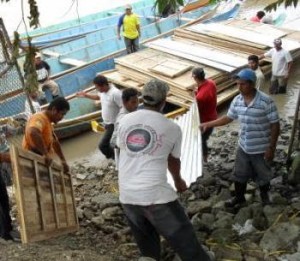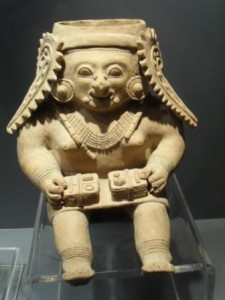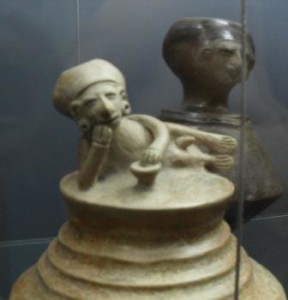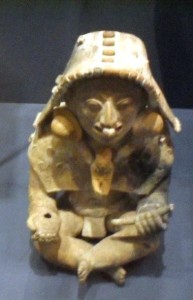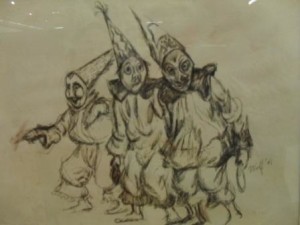There may be many reasons to visit Guayaquil, but for us this was all about bamboo. Guayaquil is the epicenter of bamboo research for low cost housing. First and foremost, this is where Jorge Moran lives. Jorge is a most extraordinary man. The recent recipient of a $1M government grant to advance the world of ecological materials, he has built many a ground breaking bamboo structure, teaches several courses at Ecuador’s leading University’s School of Architecture, and has authored over a dozen books on bamboo and is just a REALLY nice man. He has boundless energy and unyielding optimism. He is a bamboo evangelist and has been a consultant to CO2 BAMBU for the past 2 years.
.
OK, so back to Guayaquil — First stop was Hogar de Christo. This is an award winning poverty eradication program that has had a MAJOR impact in this part of the world. Hogar de Christo was started by a Catholic priest some 48 years ago and was building 1 house per week at the time. 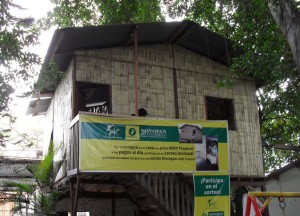 Now they build 50 houses per day. Not only that, but their whole philosophy is that there is no point in giving houses to the poor if they don’t have a means to get out of the poverty cycle. So… they started a “micro-financing” activity, which has exploded into an enormous enterprise. They have 16,000 recipients and a pay back track record of 99%. They only give to the very poorest and only to women. Of course, in order for the women to pay back, they need to have jobs, so they created technical schools. But for them to go to school and get trained, they needed to have a solution for their children, so Hogar de Christo built child care facilities. Today, there is a constant flux of people who show up every morning at the door of the Hogar de Christo facility and ask for help in the form of a bamboo house. There is an entire screening process to go through and the lucky ones who are selected to get homes are told to come back in x days and get their home kit.
Now they build 50 houses per day. Not only that, but their whole philosophy is that there is no point in giving houses to the poor if they don’t have a means to get out of the poverty cycle. So… they started a “micro-financing” activity, which has exploded into an enormous enterprise. They have 16,000 recipients and a pay back track record of 99%. They only give to the very poorest and only to women. Of course, in order for the women to pay back, they need to have jobs, so they created technical schools. But for them to go to school and get trained, they needed to have a solution for their children, so Hogar de Christo built child care facilities. Today, there is a constant flux of people who show up every morning at the door of the Hogar de Christo facility and ask for help in the form of a bamboo house. There is an entire screening process to go through and the lucky ones who are selected to get homes are told to come back in x days and get their home kit.
 Now they build 50 houses per day. Not only that, but their whole philosophy is that there is no point in giving houses to the poor if they don’t have a means to get out of the poverty cycle. So… they started a “micro-financing” activity, which has exploded into an enormous enterprise. They have 16,000 recipients and a pay back track record of 99%. They only give to the very poorest and only to women. Of course, in order for the women to pay back, they need to have jobs, so they created technical schools. But for them to go to school and get trained, they needed to have a solution for their children, so Hogar de Christo built child care facilities. Today, there is a constant flux of people who show up every morning at the door of the Hogar de Christo facility and ask for help in the form of a bamboo house. There is an entire screening process to go through and the lucky ones who are selected to get homes are told to come back in x days and get their home kit.
Now they build 50 houses per day. Not only that, but their whole philosophy is that there is no point in giving houses to the poor if they don’t have a means to get out of the poverty cycle. So… they started a “micro-financing” activity, which has exploded into an enormous enterprise. They have 16,000 recipients and a pay back track record of 99%. They only give to the very poorest and only to women. Of course, in order for the women to pay back, they need to have jobs, so they created technical schools. But for them to go to school and get trained, they needed to have a solution for their children, so Hogar de Christo built child care facilities. Today, there is a constant flux of people who show up every morning at the door of the Hogar de Christo facility and ask for help in the form of a bamboo house. There is an entire screening process to go through and the lucky ones who are selected to get homes are told to come back in x days and get their home kit.The homes are extremely rustic, but they sure beat plastic sheeting like that which some New Orleans Katrina victims still live under, years after the tragedy.
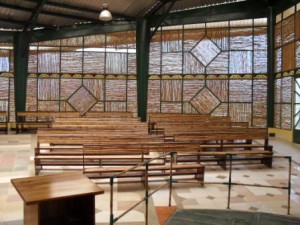 In order to get a sense of just how extensive Hogar de Christo’s reach was, I asked to go see one of the bamboo villages that are spreading on the outskirts of Guayaquil.
In order to get a sense of just how extensive Hogar de Christo’s reach was, I asked to go see one of the bamboo villages that are spreading on the outskirts of Guayaquil. 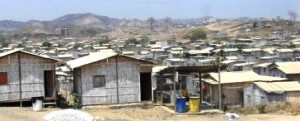 Miles and miles of bamboo houses. In order to make the bamboo housing solutions more acceptable (there remains here as everywhere a bias against bamboo as the “poor man’s wood”, one of Hogar de Christo’s staff took it upon himself to build a bamboo church. It stands on a hill, in the midst of the vast expense of bamboo homes.
Miles and miles of bamboo houses. In order to make the bamboo housing solutions more acceptable (there remains here as everywhere a bias against bamboo as the “poor man’s wood”, one of Hogar de Christo’s staff took it upon himself to build a bamboo church. It stands on a hill, in the midst of the vast expense of bamboo homes. Our friend Jorge however isn’t standing still. Having helped Hogar de Christo become the phenomal organization it is, he has shifted attention to developing a next generation of bamboo-based eco-products. With a team of 8 masters degree students, he has put together an R&D program that aims to demonstrate that bamboo houses do not need to be so rustic and can in fact be quite robust. The presentation he gave me at his University was inspiring and I intend to use several of his research tracks to benefit CO2 BAMBU.
Our friend Jorge however isn’t standing still. Having helped Hogar de Christo become the phenomal organization it is, he has shifted attention to developing a next generation of bamboo-based eco-products. With a team of 8 masters degree students, he has put together an R&D program that aims to demonstrate that bamboo houses do not need to be so rustic and can in fact be quite robust. The presentation he gave me at his University was inspiring and I intend to use several of his research tracks to benefit CO2 BAMBU. 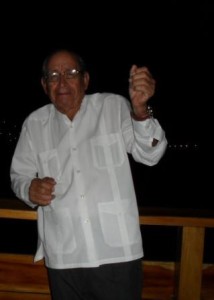
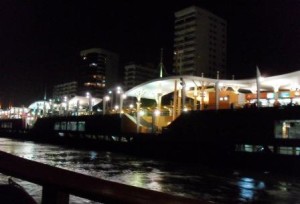 Jorge is also very proud of his city. So on the last night, after meeting with senior officials from the Ecuadoran government, and before taking off the next day to build a bamboo ranch for one of his friends, Jorge takes us out for a surprise. He has set up a ride on a “pirate ship”, a recent addition to Guayaquil’s waterfront. So off we go for late night touring, followed by succulent shrimp in coconut sauce.
Jorge is also very proud of his city. So on the last night, after meeting with senior officials from the Ecuadoran government, and before taking off the next day to build a bamboo ranch for one of his friends, Jorge takes us out for a surprise. He has set up a ride on a “pirate ship”, a recent addition to Guayaquil’s waterfront. So off we go for late night touring, followed by succulent shrimp in coconut sauce.Before we fly back to Quito, Peta and I squeeze in some tourist stuff. The highlight without a doubt is the beautiful archeological museum that stands on the edge of the river. The sculptures below are just a few pieces from the memorable earthware collection. Oddly, the archeological treasures are co-located with a contemporary art collection.
